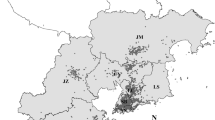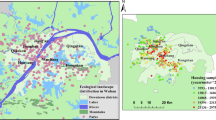Abstract
In this study, housing prices data for residential quarters from the period 2001–2012 were used and Global Differentiation Index (GDI) was established to measure the overall differentiation trend in housing prices in Yangzhou City, eastern China. Then the influence of the natural landscape and environment on prices of global housing market and housing submarkets was evaluated by the hedonic price model. The results are shown as follows. (1) There have been increasing gaps among housing prices since 2001. In this period, the differentiation trend has shown an upward fluctuation, which has been coupled with the annual growth rate of housing prices. (2) The spatial distribution of residential quarters of homogenous prices has changed from clustered in 2001 into dispersed in 2012. (3) Natural landscape and environmental externalities clearly influence spatial differentiation of housing prices. (4) In different housing submarkets, the influence of natural landscape and environmental externalities are varied. Natural landscape characteristics have significant impact on housing prices of ordinary commercial houses and indemnificatory houses, while the impact of environmental characteristics have obvious influence on housing prices of cottages and villas.
Similar content being viewed by others
References
Atkinson A B, 1970. On the measurement of inequality. Journal of Economic Theory, 2(3): 244–263.
Bourassa S C, Hoesli M, Peng V S, 2003. Do housing submarkets really matter? Journal of Housing Economics, 12(1): 12–28.
Cavailhès J, Brossard T, Foltête J C et al., 2009. GIS-based hedonic pricing of landscape. Environmental and Resource Economics, 44(4): 571–590.
Chang J S, Kim D J, 2013. Hedonic estimates of rail noise in Seoul. Transportation Research Part D: Transport and Environment, 19: 1–4.
Chen Mingxing, Lu Dadao, Zha Liangsong, 2010. The comprehensive evaluation of China’s urbanization and effects on resources and environment. Journal of Geographical Sciences, 20(1): 17–30.
Chen Yun, Wan Hao, 2011. Construction and application of bipartite recursive algorithm based on kernel density estimation: A new non-parametric method to measure the given income population scale. Statistics & Information Forum, 26(9): 3–8. (in Chinese)
Chhetri P, Han J H, Corcoran J, 2009. Modelling spatial fragmentation of the Brisbane housing market. Urban Policy and Research, 27(1): 73–89.
Chu Honejay, Liau Churnjung, Lin Chaohung et al., 2012. Integration of fuzzy cluster analysis and kernel density estimation for tracking typhoon trajectories in the Taiwan region. Expert Systems with Applications, 39(10): 9451–9457.
Davis L W, 2011. The effect of power plants on local housing values and rents. Review of Economics and Statistics, 93(4): 1391–1402.
Des R F, Lagana A, 1996. Shopping centres and house values: An empirical investigation. Journal of Property Valuation Investment, 14(4): 41–62.
Duarte C M, Tamez C G, 2009. Does noise have a stationary impact on residential values? Journal of European Real Estate Research, 2(3): 259–279.
Fang Chuanglin, Guan Xingliang, Lu Shasha et al., 2013. Input-output efficiency of urban agglomerations in China: An application of data envelopment analysis (DEA). Urban Studies, 50(13): 2766–2790.
Fang Xiaoping, Ding Sibao, 2012. Geographical spread of urban house price in China and its regional externality. Scientia Geographica Sinica, 32(2): 143–148. (in Chinese)
Feng Changchun, Li Weixuan, Zhao Fanfan, 2011. Influence of rail transit on nearby commodity housing prices: A case study of Beijing subway line five. Acta Geographica Sinica, 66(8): 1055–1062. (in Chinese)
Gamper-Rabindran S, Timmins C, 2012. Does cleanup of hazardous waste sites raise housing values? Evidence of spatially localized benefits. Journal of Environmental Economics and Management. Working Paper EE, 12–03.
Goodman A C, Thibodeau T G, 2003. Housing market segmentation and hedonic prediction accuracy. Journal of Housing Economics, 12(3): 181–201.
Ham Y J, Maddison D J, Elliott R J, 2013. The valuation of landfill disamenities in Birmingham. Ecological Economics, 85(C): 116–129
He C J, Wang Z, Guo H C et al., 2010. Driving forces analysis for residential housing price in Beijing. Procedia Environmental Sciences, 2: 925–936.
Helbich M, Jochem A, Mücke W et al., 2013. Boosting the predictive accuracy of urban hedonic house price models through airborne laser scanning. Computers, Environment and Urban Systems, 39(5):81–92.
Hong Guozhi, LI Xun, 2011. Border effect of inner city: Research based on spatial spillover of real estate price. Acta Geographica Sinica, 66(4): 468–476. (in Chinese)
Hong Tao, 2009. A comparative research on the relationship of housing prices among cities: Evidence from Yangtze River Delta and Jing-Jin-Ji Area. Statistics & Information Forum, 24(4): 58–62. (in Chinese)
Jim C Y, Chen W Y, 2007. Consumption preferences and environmental externalities: A hedonic analysis of the housing market in Guangzhou. Geoforum, 38(2): 414–431.
Koramaz T K, Dokmeci V, 2012. Spatial determinants of housing price values in Istanbul. European Planning Studies, 20(7): 1221–1237.
Kuethe T H, 2012. Spatial fragmentation and the value of residential housing. Land Economics, 88(1): 16–27.
Landry C E, Hindsley P, 2011. Valuing beach quality with hedonic property models. Land Economics, 87(1): 92–108.
Li Xun, Fu Wenying, 2010. Investigation of the capitalization of municipal government infrastructure investment on housing market: Hedonic model based on Guangzhou housing price data. Geographical Research, 29(7): 1269–1280. (in Chinese)
Machin S. Houses and schools: Valuation of school quality through the housing market. Labour Economics, 2011, 18(6): 723–729
Mahan B L, Polasky S, Adams R M, 2000. Valuing urban wetlands: A property approach. Land Economics, 76(1): 100–103.
Maslianskaia-Pautrel M, Baumont C, 2013. Spatial weights configuration and impact of environmental externalities on housing prices. tAvailable at SSRN: http://ssrn.com/abstract=2071199 or http://dx.doi.org/10.2139/ ssrn.2071199.
Panduro T E, Veie K L, 2013. Classification and valuation of urban green spaces: A hedonic house price valuation. Landscape and Urban Planning, 120: 119–128.
Platter R H, Campbell T J, 1978. A study of the effect of water view on site value. The Appraisal Journal, 46(1): 22–25.
Rosen S, 1974. Hedonic prices and implicit markets: Product differentiation in pure competition. Journal of Political Economy, 82(1): 34–55.
Shi Yishao, Li Muxiu, 2006. The analysis of housing price gradient and its impact factors of Shanghai city. Acta Geographica Sinica, 61(6): 604–612. (in Chinese)
Shi Yishao, Zhang Rui, 2010. Temporal spatial impact effects of large-scale parks on residential prices: Exemplified by the Huangxing Park in Shanghai. Geographical Research, 29(3): 510–520. (in Chinese)
Smersh G T, Smith M T, 2000. Accessibililty changes and urban house price appreciation: A constrained optimization approach to determining distance effects. Journal of Housing Economics, 9(3): 187–196.
Song Y, Zenou Y, 2012. Urban villages and housing values in China. Regional Science and Urban Economics, 42(3): 495–505.
Stevenson S, 2004. New empirical evidence on heteroscedasticity in hedonic housing models. Journal of Housing Economics, 13(2): 136–153.
Straszheim M, 1975. An Econometric Analysis of the Urban Housing Market. National Bureau of Economic Research. New York: Columbia University Press, 28.
Tse R, Love P, 2000. Measuring residential property values in Hong Kong. Property Management, 18(5): 366–374.
Waltert F, Schläpfer F, 2010. Landscape amenities and local development: A review of migration, regional economic and hedonic pricing studies. Ecological Economics, 70(2), 141–152.
Wang Yang, Fang Chuanglin, Xiu Chunliang et al., 2012. A new approach to measurement of regional inequality in particular directions. Chinese Geographical Science, 22(6): 705–717.
Wang Yang, Wang Deli, Wang Shaojian, 2013. Spatial differentiation patterns and impact factors of housing prices of China’s cities. Scientia Geographica Sinica, 33(10): 1157–1165. (in Chinese)
Wen Haizhen, Li Xuning, Zhang Ling, 2012. Impacts of the urban landscape on the housing pricing: A case study in Hangzhou. Geographical Research, 31(10): 1806–1814. (in Chinese)
Yusuf A A, Resosudarmo B P, 2009. Does clean air matter in developing countries’ megacities? A hedonic price analysis of the Jakarta housing market, Indonesia. Ecological Economics, 68(5): 1398–1407.
Author information
Authors and Affiliations
Corresponding author
Additional information
Foundation: National Natural Science Foundation of China, No.41401164, No.41201128
Author: Wang Yang (1984–), PhD, specialized in urban geography, regional and urban planning.
Zhao Lingling, PhD
Rights and permissions
About this article
Cite this article
Wang, Y., Zhao, L., Sobkowiak, L. et al. Impact of urban landscape and environmental externalities on spatial differentiation of housing prices in Yangzhou City. J. Geogr. Sci. 25, 1122–1136 (2015). https://doi.org/10.1007/s11442-015-1223-6
Received:
Accepted:
Published:
Issue Date:
DOI: https://doi.org/10.1007/s11442-015-1223-6




